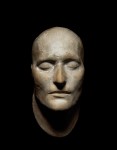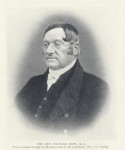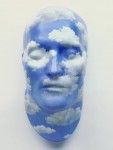 One of only two plaster death masks of Napoleon Bonaparte remaining in private hands sold on Wednesday at Bonhams’ Book, Map and Manuscript sale in London for £169,250 ($260,000). The death mask was made by surgeon Francis Burton of Britain’s Sixty-Sixth Regiment of Foot on May 7th, 1821, two days after Napoleon’s death on St. Helena. Madame Bertrand, the former emperor’s attendant in exile and wife of General Bertrand, Napoleon’s Grand Marshal, insisted the death mask be taken even though plaster was hard to come by on the remote Atlantic island. By the time enough plaster was scared up on a neighboring island, Napoleon’s body had begun to decompose so even though she initially refused to let an Englishman make a mould of Napoleon’s face, Madame succumbed to the inevitable: it was either the Englishman or nobody.
One of only two plaster death masks of Napoleon Bonaparte remaining in private hands sold on Wednesday at Bonhams’ Book, Map and Manuscript sale in London for £169,250 ($260,000). The death mask was made by surgeon Francis Burton of Britain’s Sixty-Sixth Regiment of Foot on May 7th, 1821, two days after Napoleon’s death on St. Helena. Madame Bertrand, the former emperor’s attendant in exile and wife of General Bertrand, Napoleon’s Grand Marshal, insisted the death mask be taken even though plaster was hard to come by on the remote Atlantic island. By the time enough plaster was scared up on a neighboring island, Napoleon’s body had begun to decompose so even though she initially refused to let an Englishman make a mould of Napoleon’s face, Madame succumbed to the inevitable: it was either the Englishman or nobody.
Burton’s mould was done in at least two sections — face from eyebrows to chin, back of the head (possibly in two parts) — and at some point in the process Napoleon’s Corsican doctor Francesco Antommarchi, who had earlier insisted a death mask could not be made due the dearth of materials, joined the work in process. The next day, Burton made a positive cast from the moulds, but the face cast stuck to the original mould which could then only be removed by destroying it, so all that was left of Napoleon’s death mask was the mould of the back of his head and the positive cast.
 While the face cast was drying, Burton left Longwood House, Napoleon’s residence, and Mme Bernard took advantage of the opportunity to take the cast so copies can be made in Europe, leaving dirty English hands out of it. Burton was promised a copy, but never received one. He had to settle for keeping the moulds of the back of the head which he reportedly destroyed in rage after his attempts to secure the promised copy failed.
While the face cast was drying, Burton left Longwood House, Napoleon’s residence, and Mme Bernard took advantage of the opportunity to take the cast so copies can be made in Europe, leaving dirty English hands out of it. Burton was promised a copy, but never received one. He had to settle for keeping the moulds of the back of the head which he reportedly destroyed in rage after his attempts to secure the promised copy failed.
Antommarchi and Bertrand remained on St. Helena until the end of the month. A source of plaster was fortuitously discovered on the island giving them the opportunity to work on a complete death mask. Since they’d pissed off Burton, they didn’t have access to the ears, neck, upper forehead, etc., so they enlisted the aid of artist and miniaturist Joseph William Rubidge who was the only professional artist on the island and whose drawing of the dead emperor would later become a popular print in its own right. Rubidge recreated the missing parts and combined them with the positive face cast to create the one authentic death mask.
 Before the group’s departure, two casts made from the prototype were given to the Reverend Richard Boys, Senior Chaplain of St. Helena, who despite his Englishness was popular with the French contingent. He remained on the island for eight years after Napoleon’s death. Upon his return, he carried the death masks and several other mementos of the emperor. He gave one mask to his daughter Mrs. Sankey (ie, the Sankey cast, now at the Maison Française d’Oxford) and the other to his son, the Venerable Archdeacon Markby Boys (ie, the Boys cast). The latter has remained in the Boys family until now. The seller, Andrew Boys, is the great-great-great-great-great nephew of Rev. Richard Boys.
Before the group’s departure, two casts made from the prototype were given to the Reverend Richard Boys, Senior Chaplain of St. Helena, who despite his Englishness was popular with the French contingent. He remained on the island for eight years after Napoleon’s death. Upon his return, he carried the death masks and several other mementos of the emperor. He gave one mask to his daughter Mrs. Sankey (ie, the Sankey cast, now at the Maison Française d’Oxford) and the other to his son, the Venerable Archdeacon Markby Boys (ie, the Boys cast). The latter has remained in the Boys family until now. The seller, Andrew Boys, is the great-great-great-great-great nephew of Rev. Richard Boys.
Owner of the mask, Andrew Boys, explains how it came down through his family and into his hands: “At a family funeral I was rather surprised and taken aback, to hear that I had been left this mask. After a while I realized its significance but I was not sure what to do with it beyond ensuring its safety. To date it has been confined to an attic but I most definitely did not want this to happen for another generation. I came to the conclusion that the best thing to do was to offer it for sale in the hope that, as a result, it was something more people would then be able to see and enjoy”.
A donation to a museum might have been a more secure way of seeing that dream come true. There’s no news on who the buyer is.
 Anyway, on May 27th, 1821, Bertrand and the rest of the French contingent left the island, the prototype cast stashed in Antommarchi’s bag. That prototype would be used to make plaster and bronze copies which would be sold all over Europe. It would become so recognizable an image that surrealist artist René Magritte painted a blue sky and clouds over no fewer than five plaster copies of Napoleon’s face mask to represent L’Avenir des Statues (The Future of Statues). Here’s one of them at the Tate.
Anyway, on May 27th, 1821, Bertrand and the rest of the French contingent left the island, the prototype cast stashed in Antommarchi’s bag. That prototype would be used to make plaster and bronze copies which would be sold all over Europe. It would become so recognizable an image that surrealist artist René Magritte painted a blue sky and clouds over no fewer than five plaster copies of Napoleon’s face mask to represent L’Avenir des Statues (The Future of Statues). Here’s one of them at the Tate.